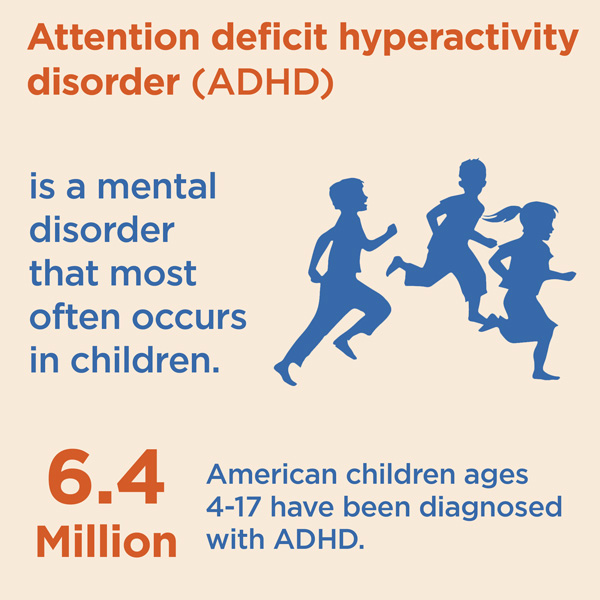Overview


Attention deficit hyperactivity disorder (ADHD) is a mental disorder that most often occurs in children. Symptoms of ADHD include trouble concentrating, paying attention, staying organized, and remembering details.
It can be a difficult condition to diagnose. Children with untreated ADHD are sometimes mislabeled as troublemakers or problem children. Make sure you know the basic facts and symptoms of ADHD.
5 Fast Facts
- Males are almost three times more likely to be diagnosed with ADHD than females.
- During their lifetimes, 12.9 percent of men will be diagnosed with the attention disorder. Just 4.9 percent of women will be diagnosed.
- The average age of ADHD diagnosis is 7 years old.
- Symptoms of ADHD typically first appear between the ages of 3 and 6.
- ADHD isn’t just a childhood disorder. Today, about 4 percent of American adults over the age of 18 deal with ADHD on a daily basis.
Demographics

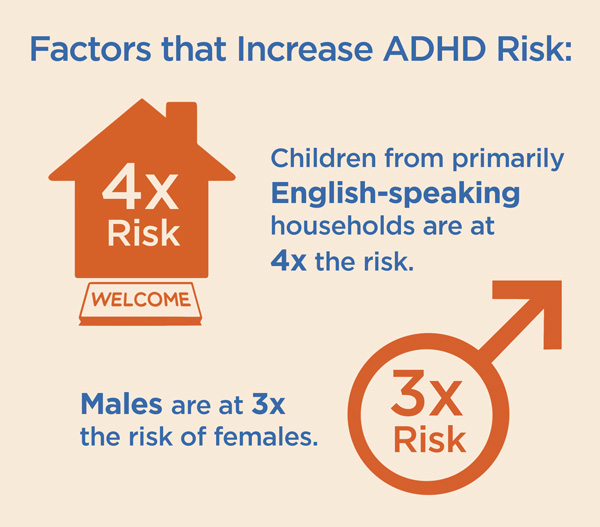
There are demographic factors that impact the risks of being diagnosed with ADHD. Children living in households where English is the main language are more than four times as likely to be diagnosed as children living in households where English is the second language. And children living in households that make less than two times the federal poverty level have a higher risk than children from higher-income households.
Certain conditions might affect certain races in different ways, but ADHD impacts children of all races. From 2001 to 2010, the rate of ADHD among non-Hispanic black girls increased 90 percent.
ADHD affects children of all races, including:
- whites: 9.8%
- blacks: 9.5%
- Latinos: 5.5%
Children are also diagnosed at different ages. Detecting symptoms differs from case to case, and the more severe, the earlier the diagnosis.
- 8 years old: average age of diagnosis for children with mild ADHD
- 7 years old: average age of diagnosis for children with moderate ADHD
- 5 years old: average age of diagnosis for children with severe ADHD
On The Rise
Cases and diagnoses of ADHD have been increasing dramatically in the past few years. The American Psychiatric Association (APA) says that 5 percent of American children have ADHD. But the Centers for Disease Control and Prevention (CDC) puts the number at more than double the APA’s number. The CDC says that 11 percent of American children, ages 4 to 17, have the attention disorder.  That’s an increase of 42 percent in just eight years.
- 2003: 7.8%
- 2007: 9.5%
- 2011: 11 %
50 States


An estimated 6.4 million American children ages 4-17 have been diagnosed with ADHD. The incidence of ADHD is higher in some states than others. Generally, states in the Western parts of the United States have the lowest rates of ADHD. Nevada has the lowest rates. States in the Midwest seem to have the highest rates. Kentucky has the highest rates.
- Nevada: 4.2%
- New Jersey: 5.5%
- Colorado, 5.6%
- Utah: 5.8%
- California: 5.9%
- Kentucky: 14.8%
- Arkansas: 14.6%
- Louisiana: 13.3%
- Indiana: 13.0%
- Delaware and South Carolina: 11.7%
Treatments
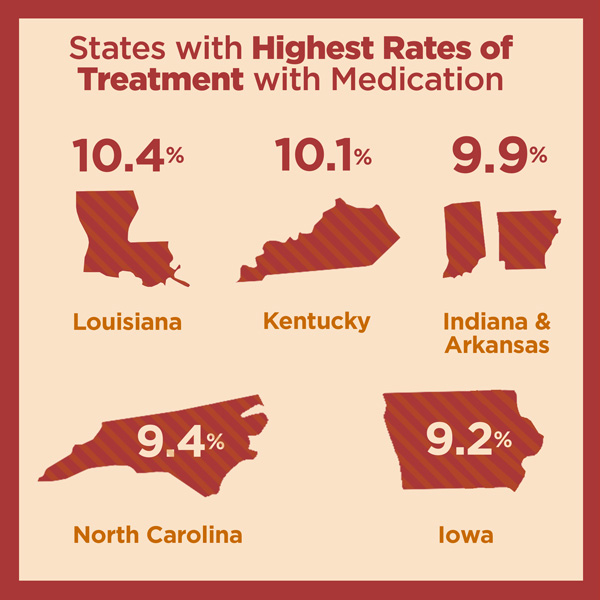
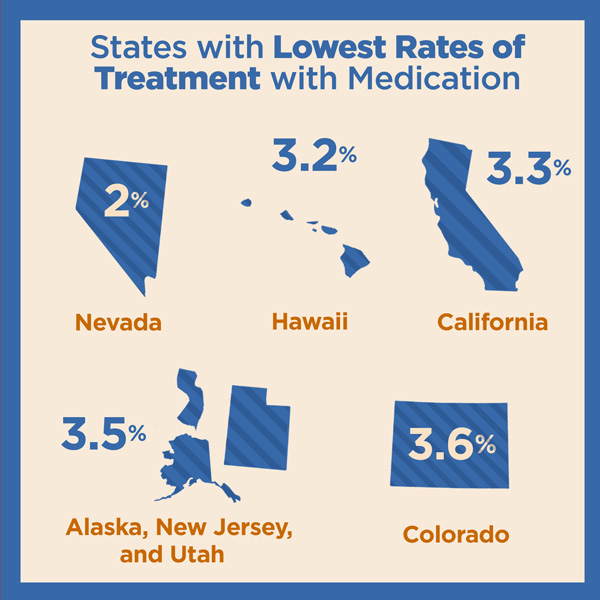
Currently, 6.1 percent of all American children are being treated for ADHD with medication. Some states have higher rates of treatment with medication than others. One in five American children who has been diagnosed with ADHD is not receiving medicine or mental health counseling for their disorder.
- Nevada: 2%
- Hawaii: 3.2%
- California: 3.3%
- Alaska, New Jersey, and Utah: 3.5%
- Colorado: 3.6%
- Louisiana: 10.4%
- Kentucky: 10.1%
- Indiana and Arkansas: 9.9%
- North Carolina: 9.4%
- Iowa: 9.2%
ADHD & Other Conditions
ADHD doesn’t increase a person’s risk for other conditions or diseases. But some people with ADHD — especially children — are more likely to experience a range of co-existing conditions. They can sometimes make social situations more difficult or school more challenging.
Some co-existing conditions include:
- learning disabilities
- conduct disorders and difficulties, including antisocial behavior, fighting, and oppositional defiant disorder
- anxiety disorder
- depression
- bipolar disorder
- Tourette’s syndrome
- substance abuse
- bed-wetting problems
- sleep disorders
Medical Costs


Cost is a major factor when it comes to how a condition affects someone. Treatment plans and medications can be expensive, and planning around payment can be stressful. A study from 2007 claimed that the “cost of illness†for a person with ADHD is $14,576 each year. That means ADHD costs Americans $42.5 billion dollars each year — and that’s on the conservative side of ADHD prevalence estimates.
Medicines and treatments aren’t the only costs to consider when dealing with an ADHD diagnosis. Other factors that can make a dent in your pocketbook include:
- education expenses
- loss of work
- juvenile justice
- healthcare costs
Different Symptoms

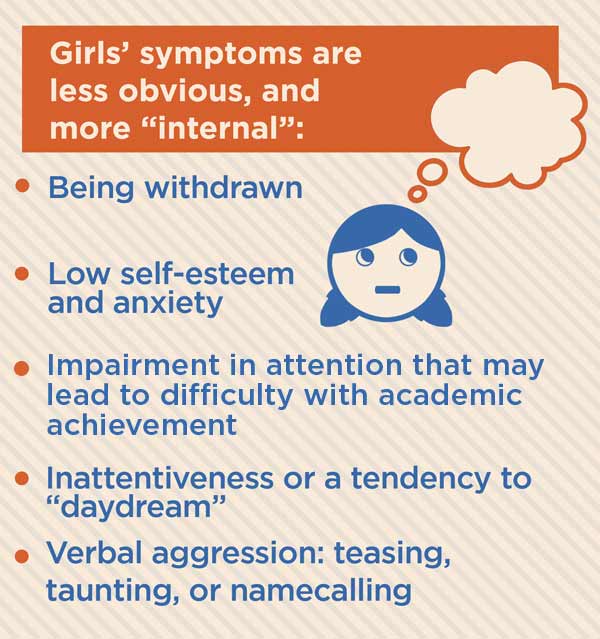
Boys and girls can display very different ADHD symptoms, and boys are much more likely to be diagnosed with the attention disorder. Why? It’s possible the nature of ADHD symptoms in boys makes their condition more noticeable than it is in girls.
Boys tend to display externalized symptoms that most people think of when they think of ADHD behavior, for example:
- impulsivity or “acting outâ€
- hyperactivity, such as running and hitting
- lack of focus, including inattentiveness
- physical aggression
ADHD in girls is often easy to overlook because it’s not “typical†ADHD behavior. The symptoms aren’t as obvious as they are in boys. They can include:
- being withdrawn
- low self-esteem and anxiety
- impairment in attention that may lead to difficulty with academic achievement
- inattentiveness or a tendency to “daydreamâ€
- verbal aggression: teasing, taunting, or name-calling

